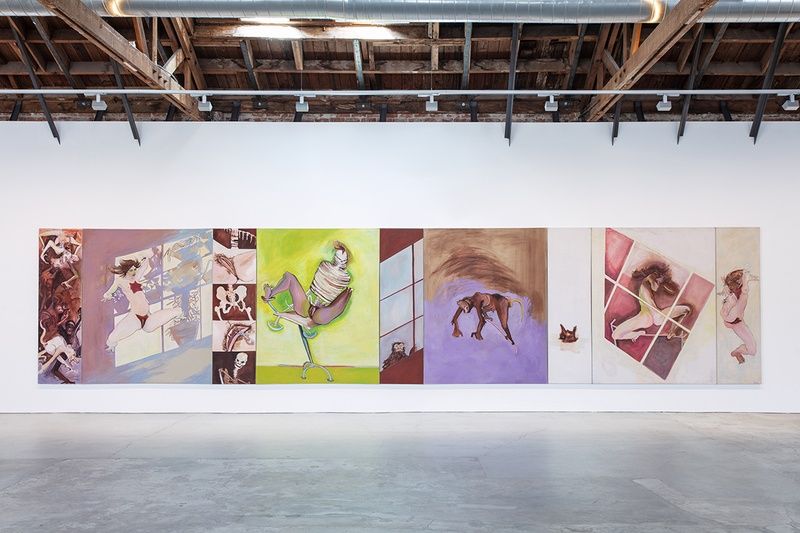James Fuentes Gallery
Juanita McNeely
Moving Through
“Juanita opened up a world to the viewer of an imagination that had traveled through the extremes of feeling and managed to extract from it a dynamic and moving panorama of life and art, ever resistant and amazingly resilient, beautiful, rich, and alive.”
—Joan Semmel (from Semmel’s essay, “Towering in Spirit” in James Fuentes Press Vol. 5: Juanita McNeely, 2022)
James Fuentes is pleased to present Juanita McNeely: Moving Through, an exhibition of three large-scale, multi-panel paintings from 1975, 1976, and 1977. This presentation marks McNeely's debut solo exhibition in Los Angeles, following the gallery’s first exhibition of her work in New York in 2020, which featured her thirteen-panel piece, Triskaidekaptych (1986), and nine-panel Is It Real? Yes, It Is! (1969), now in the collection of the Whitney Museum of American Art. The three works on view, comprising 23 panels in total, portray bodies acrobatically suspended in ambient space—unconstrained by gravity in the atmosphere of her canvas. McNeely first witnessed multi-panel paintings in the work of Max Beckman, who she studied under at the St. Louis School of Fine Arts at Washington University. Hung low to the ground and lining her studio, this format permitted a flow state without directive for where movement should begin or end—through which McNeely’s images could ultimately come to contain multiple dimensions of reality.
As writer Sharyn Finnegan observes: “Juanita’s color is the seductress for a painting that might be difficult to look at. Her earliest work is her darkest in terms of value and not long after she would burst out as a natural colorist, realizing that it makes the work thrum with life, drawing the viewer in.” Seeming to pinpoint this graduation from the more intense contrasts in shadow and hue of her earliest works, Moving Through (1975) overflows with vibrance across its nine canvases, emptying into lighter space toward its final third. Successively, From the Black Space I (1976) and From the Black Space II (1977) spring entirely into monochromatic negative space, siphoning shades of bloody red and shadows filled in green and purple. And so, although ambitious in scale, McNeely’s canvases are lithe, employing turpentine and poppy-seed oil to keep the painting’s surface lean, fresh, and in equilibrium with their weighty content. These compositions express an aspiration to discover a means, regardless of ailment or injury, to be physically, mentally, and energetically present.
From the inception of her creative practice, McNeely has produced figurative work that defies the conventions of art history, approaching the human form as a source of power, emotion, movement, and rupture. In the 1950s, when formal artistic training entailed life drawing with models (“their stillness seemed deadly, lacking of life”), McNeely insisted upon rendering the figure from her own memory, informed by an intent, continual observation of people and the way they moved in the world. More broadly, when Abstract Expressionism dictated innovation, she instead drew influence from the vibrance and physicality of German Expressionism—challenging figuration to absorb her sensations and improvisations. In this way, even in her portraits of others, essential to comprehending McNeely’s work is her own experience of the body as a site of intense aliveness, endurance, pleasure, and pain. Asked about the prominence of blood in her work, McNeely offers: “That's how you give birth. That's how you die. That's how you live." In the vein of Maria Lassnig’s “body awareness” paintings and Carolee Schneeman’s Up to and Including Her Limits, McNeely is unafraid to involve her body completely—to give all of herself—determined to make honest work about an experience that is not controlled or dictated by patriarchal structures. For over six decades, McNeely’s paintings have been a geyser of creative, political, and bodily agency.
With this exhibition, McNeely’s multi-panel paintings will simultaneously be viewable across three cities in the United States. As well as the three works on view in Los Angeles, McNeely’s Is It Real? Yes, It Is! (1969) can be seen at the Whitney Museum in New York, while her four-panel Woman’s Psyche (1968) is on view at the Rubell Museum in Washington DC.
Juanita McNeely was born in St. Louis, Missouri, in 1936 and lived and worked in New York City. She received a BFA from the St. Louis School of Fine Arts at Washington University, and an MFA from Southern Illinois University. McNeely has been the subject of solo exhibitions at James Fuentes, Mitchell Algus Gallery, Brandeis University, Montclair State University, and Elaine Benson Gallery, and has been featured in group exhibitions at the Whitney Museum and Rubell Museum. Her work is in the collections of the the Whitney Museum; Women's Studies Research Center at Brandeis University; the Minneapolis Institute of Art; the National Museum of History & Art in Taipei; the Oakleigh Collection at Skidmore College; Palacio de las Bellas Artes in Mexico City; the Rubell Collection; the Morris Library at Southern Illinois University; and the William and Uyendale Scott Memorial Women Artists Study Collection at Bryn Mawr College.

Panel 6 of From the Black Space II, 1977
Oil on linen
6 panels, overall: 84 × 312 inches
Works

From the Black Space I, 1976
Oil on linen
7 panels, overall: 84 × 312 × 2 inches

Moving Through, 1975
Oil on canvas
9 panel, overall: 84 × 408 × 2 inches

From the Black Space II, 1977
Oil on linen
7 panels, overall: 84 × 312 × 2 inches

Detail (panel 1):
From the Black Space I, 1976
Signed verso
Oil on linen
84 × 24 × 2 inches